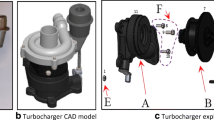Abstract
At the end-of-life (EOL) of a product, there are several options available for its processing including reuse, remanufacturing, recycling and disposing. In almost all cases, a certain level of disassembly may be necessary. Thus, finding an optimal (or near optimal) disassembly sequence is crucial to increasing the efficiency of the process. Disassembly operations are labor intensive, can be costly, have unique characteristics and cannot be considered as the reverse of assembly operations. Since the complexity of determining the best disassembly sequence increases with increase in the number of parts of the product, it is extremely crucial that an efficient methodology for disassembly sequencing be developed. In this paper, we present a genetic algorithm for disassembly sequencing of EOL products. A case example is considered to demonstrate the functionality of the algorithm.
Similar content being viewed by others
References
Gupta SM, Taleb K (1994) Scheduling disassembly. Int J Prod Res 32(8):1857–1866
Taleb K, Gupta SM (1997) Disassembly of multiple product structures. Comput Ind Eng 32(4):949–961
Taleb KN, Gupta SM, Brennan L (1997) Disassembly of complex products with parts and materials commonality. Prod Plan Control 8(3):255–269
Veerakamolmal P, Gupta SM, McLean CR (1997) Disassembly process planning. 1st international conference on engineering design and automation, Bangkok, Thailand, pp 162–165
Veerakamolmal P, Gupta SM (1998) Optimal analysis of lot size balancing for multi-products selective disassembly. Int J Flex Automat Integr Manuf 6(3/4):245–269
Veerakamolmal P, Gupta SM (1999) Analysis of design efficiency for the disassembly of modular electronic products. J Electron Manuf 9(1):79–95
Kuo TC (2000) Disassembly sequence and cost analysis for electromechanical products. Robot Com-Int Manuf 16(1):43–54
Torres F, Gil P, Puente ST, Pomares J, Aracil R (2004) Automatic PC disassembly for component recovery. Int J Adv Manuf Technol 23(1/2):39–46
Moore KE, Gungor A, Gupta SM (2001) Petri net approach to disassembly process planning for products with complex AND/OR precedence relationships. Eur J Oper Res 135(2):428–449
Gungor A, Gupta SM (2001) Disassembly sequence plan generation using a branch-and-bound algorithm. Int J Prod Res 39(3):481–509
Lambert AJD, Gupta SM (2002) Demand-driven disassembly optimization for electronic products. J Electron Manuf 11(2):121–135
Kongar E, Gupta SM (2002) A multi-criteria decision making approach for disassembly-to-order systems. J Electron Manuf 11(2):171–183
Brennan L, Gupta SM, Taleb KN (1994) Operations planning issues in an assembly/disassembly environment. Int J Oper Prod Man 14(9):57–67
Gupta SM, McLean CR (1996) Disassembly of products. Comput Ind Eng 31:225–228
Moyer L, Gupta SM (1997) Environmental concerns and recycling/disassembly efforts in the electronics industry. J Electron Manuf 7(1):1–22
Gungor A, Gupta SM (1999) Issues in environmentally conscious manufacturing and product recovery: a survey. Comput Ind Eng 36(4):811–853
Tang Y, Zhou M, Zussman E, Caudill R (2000) Disassembly modeling, planning, and application: a review. IEEE international conference on robotics and automation, San Francisco, California, pp 2197–2202
Lee D-H, Kang J-G, Xirouchakis P (2001) Disassembly planning and scheduling: review and further research. J Eng Manuf 215(B5):695–709
Lambert AJD (2003) Disassembly sequencing: a survey. Int J Prod Res 41(16):3721–3759
Lambert AJD, Gupta SM (2005) Disassembly modeling for assembly, maintenance, reuse, and recycling. CRC Press, Boca Raton, Florida
Valenzuela-Rendon M, Uresti-Charre E (1997) A non-generational genetic Algorithm for multiobjective optimization. 7th international conference on genetic algorithms, pp 658–665
Keung KW, Ip WH, Lee TC (2001) The solution of a multi-objective tool selection model using the GA approach. Int J Adv Manuf Technol 18:771–777
Loughlin DH, Ranjithan S (1997) The neighborhood constraint-method: a genetic algorithm-based multiobjective optimization technique. 7th international conference on genetic algorithms, pp 666–673
Lazzerini B, Marcelloni F (2000) A genetic algorithm for generating optimal assembly plans. Artif Intell Eng 14:319–329
Sanderson AC, Homem de Mello LS, Zhang H (1990) Assembly sequence planning. AI Magazine, Spring 1990, pp 62–81
Seo K-K, Park J-H, Jang D-S (2001) Optimal disassembly sequence using genetic algorithms considering economic and environmental aspects. Int J Adv Manuf Technol 18:371–380
Bierwirth C, Mattfeld DC, Kopfer H (1996) On permutation representations for scheduling problems. In: Voigt HM, Ebeling W, Rechenberg I, Schwefel H-P (eds) Parallel problem solving from nature-PPSN IV. Springer, Berlin Heidelberg New York, pp 310–318
Bierwirth C, Mattfeld DC (1999) Production scheduling and rescheduling with genetic algorithms. Evol Comput 7(1):1–18
Author information
Authors and Affiliations
Corresponding author
Rights and permissions
About this article
Cite this article
Kongar, E., Gupta, S.M. Disassembly sequencing using genetic algorithm. Int J Adv Manuf Technol 30, 497–506 (2006). https://doi.org/10.1007/s00170-005-0041-x
Received:
Accepted:
Published:
Issue Date:
DOI: https://doi.org/10.1007/s00170-005-0041-x




